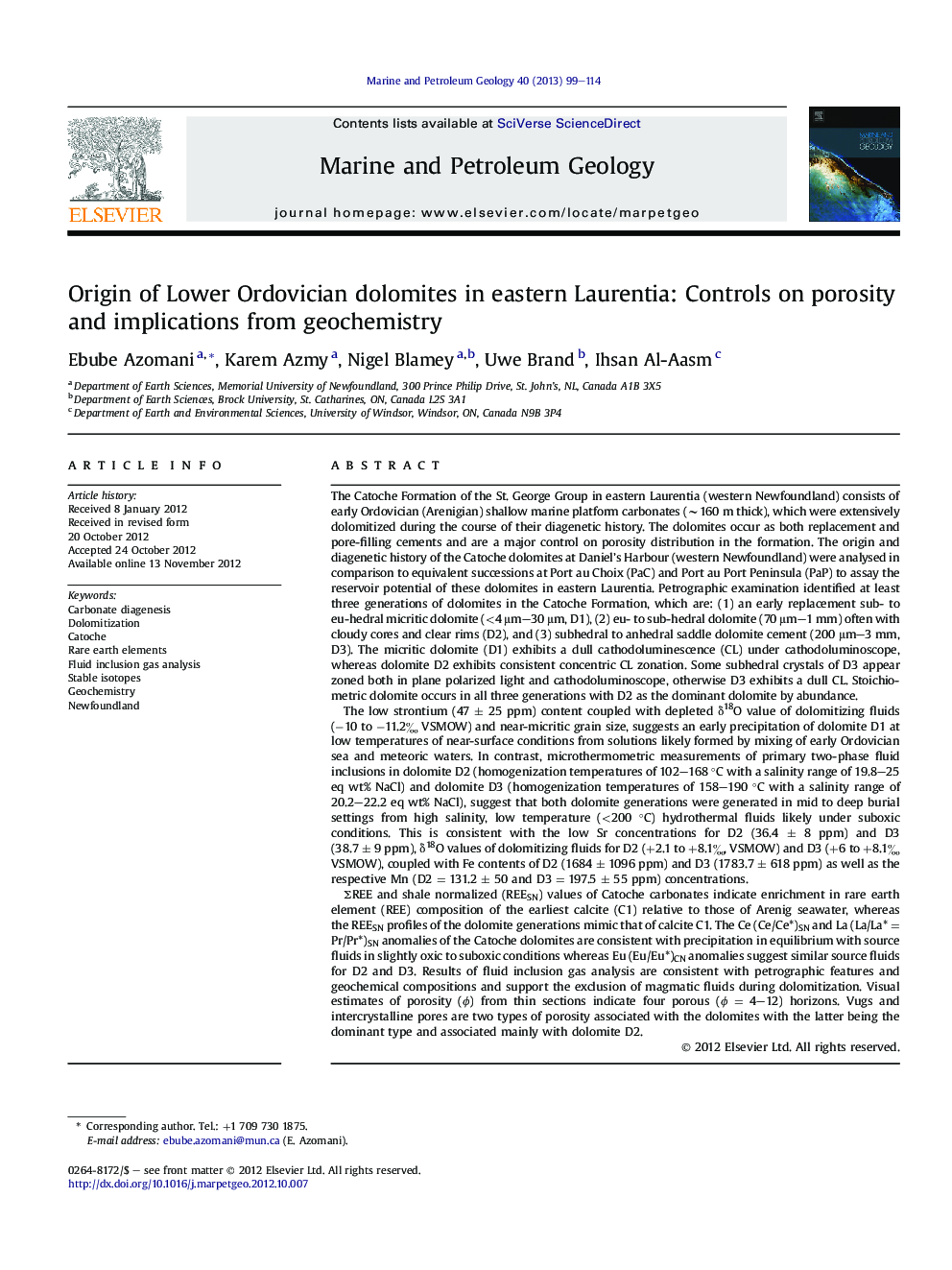| کد مقاله | کد نشریه | سال انتشار | مقاله انگلیسی | نسخه تمام متن |
|---|---|---|---|---|
| 4695805 | 1637184 | 2013 | 16 صفحه PDF | دانلود رایگان |
The Catoche Formation of the St. George Group in eastern Laurentia (western Newfoundland) consists of early Ordovician (Arenigian) shallow marine platform carbonates (∼160 m thick), which were extensively dolomitized during the course of their diagenetic history. The dolomites occur as both replacement and pore-filling cements and are a major control on porosity distribution in the formation. The origin and diagenetic history of the Catoche dolomites at Daniel's Harbour (western Newfoundland) were analysed in comparison to equivalent successions at Port au Choix (PaC) and Port au Port Peninsula (PaP) to assay the reservoir potential of these dolomites in eastern Laurentia. Petrographic examination identified at least three generations of dolomites in the Catoche Formation, which are: (1) an early replacement sub- to eu-hedral micritic dolomite (<4 μm–30 μm, D1), (2) eu- to sub-hedral dolomite (70 μm–1 mm) often with cloudy cores and clear rims (D2), and (3) subhedral to anhedral saddle dolomite cement (200 μm–3 mm, D3). The micritic dolomite (D1) exhibits a dull cathodoluminescence (CL) under cathodoluminoscope, whereas dolomite D2 exhibits consistent concentric CL zonation. Some subhedral crystals of D3 appear zoned both in plane polarized light and cathodoluminoscope, otherwise D3 exhibits a dull CL. Stoichiometric dolomite occurs in all three generations with D2 as the dominant dolomite by abundance.The low strontium (47 ± 25 ppm) content coupled with depleted δ18O value of dolomitizing fluids (−10 to −11.2‰ VSMOW) and near-micritic grain size, suggests an early precipitation of dolomite D1 at low temperatures of near-surface conditions from solutions likely formed by mixing of early Ordovician sea and meteoric waters. In contrast, microthermometric measurements of primary two-phase fluid inclusions in dolomite D2 (homogenization temperatures of 102–168 °C with a salinity range of 19.8–25 eq wt% NaCl) and dolomite D3 (homogenization temperatures of 158–190 °C with a salinity range of 20.2–22.2 eq wt% NaCl), suggest that both dolomite generations were generated in mid to deep burial settings from high salinity, low temperature (<200 °C) hydrothermal fluids likely under suboxic conditions. This is consistent with the low Sr concentrations for D2 (36.4 ± 8 ppm) and D3 (38.7 ± 9 ppm), δ18O values of dolomitizing fluids for D2 (+2.1 to +8.1‰, VSMOW) and D3 (+6 to +8.1‰ VSMOW), coupled with Fe contents of D2 (1684 ± 1096 ppm) and D3 (1783.7 ± 618 ppm) as well as the respective Mn (D2 = 131.2 ± 50 and D3 = 197.5 ± 55 ppm) concentrations.ΣREE and shale normalized (REESN) values of Catoche carbonates indicate enrichment in rare earth element (REE) composition of the earliest calcite (C1) relative to those of Arenig seawater, whereas the REESN profiles of the dolomite generations mimic that of calcite C1. The Ce (Ce/Ce*)SN and La (La/La* = Pr/Pr*)SN anomalies of the Catoche dolomites are consistent with precipitation in equilibrium with source fluids in slightly oxic to suboxic conditions whereas Eu (Eu/Eu*)CN anomalies suggest similar source fluids for D2 and D3. Results of fluid inclusion gas analysis are consistent with petrographic features and geochemical compositions and support the exclusion of magmatic fluids during dolomitization. Visual estimates of porosity (ϕ) from thin sections indicate four porous (ϕ = 4–12) horizons. Vugs and intercrystalline pores are two types of porosity associated with the dolomites with the latter being the dominant type and associated mainly with dolomite D2.
► Dolomitization of upper St. George Group (western Newfoundland).
► Fluid inclusion gas analyses in hydrothermal dolomites.
► Origin of dolomites reflected by their REE geochemistry.
► Stable isotope signatures of hydrothermal dolomites in eastern Laurentia.
► Controls of dolomitization on porosity distribution patterns.
Journal: Marine and Petroleum Geology - Volume 40, February 2013, Pages 99–114
